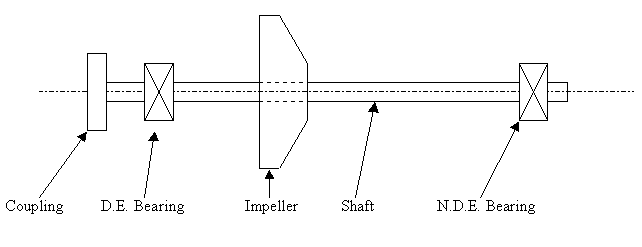|
| Plant Maintenance Resource Center
Tips For Blower Maintenance
| |
|
|
|
|
|
Tips For Blower MaintenanceAuthor : Ashish Bhartia The article is intended to provide a few tips to plant maintenance professionals, in reducing the downtime and increasing the reliability, of blowers. Generally the apparent reasons for blower failure are:
The most common reason for these is unbalance of the rotor assembly. It is noted that if balancing of the rotor is checked / rectified as and when time permits, especially during the Shutdowns / Turnarounds, a marked improvement in the performance shall be visible in Blower performance. This is easier said then done. Due to various constraints this exercise is often omitted. For such cases it will always be useful to atleast do static balancing of the assembly on site. This is an easy exercise and the time requirements are also very minimal. Consider a typical blower arrangement:
Consider the problem of Maintenance Engineer in case of bearing failure: He is much at ease in case it is a N.D.E. Bearing, which has failed, and can get the machine on line after replacing the N.D.E. Bearing and realigning the drive. This job is complicated and becomes time consuming in case the bearing does not come out with help of a puller, and in that case at times gas cutting of inner race has to be done. This also aggravates the chances of damaging the shaft, which would result in a major maintenance work. In the case of D.E. Bearing failure, over and above the above mentioned consideration a new jobs comes in, that is removal of the coupling half. Normally as recommended couplings are interference fits, and removing them is a very time consuming job. At times it has been noted that many plant engineers keeping this difficulty in mind go in for a slight clearance fit for coupling halves. Though no engineer would admit freely, the same procedure for increasing the clearance slightly is followed for bearing fitting also, so as to ease the removal of these after failure. Though it is not a good practice but the pressure that a plant engineer has to face for handing over the breakdown machine normally forces him to adopt these practical techniques. The best solution for these kinds of situations is to go in for Split type bearings in blowers. The introduction of Split Bearing eliminates totally all the above stated problems and the maintenance time required comes down drastically in case of failures. Also the performance of Split bearings is in no way inferior to normal bearings. Only adverse criterion why the OEM's do not recommend this bearing is the high cost of this type of bearings. It is recommended that the plant engineer should at least study the cost benefits of conversion to this type of a bearing and normally he shall find it to be a more economic choice. It is always advisable to contact the manufacturer of the bearing for designing and recommending the best selection for the given drive. It shall be noted that after following the above two recommendations, that is balancing of the rotor and changing of the bearing types, the operational and maintenance performance improvement of the said blower would be quite visible. The one factor which shall help in even better performance of the blower is proper coupling selection. It is again noted that the OEM normally selects the coupling based on economy principles and the couplings generally recommended are like: Spring type coupling, Gear type Coupling, Tyre couplings etc. These couplings are good from the point of economy but require constant maintenance in form of greasing or wear and tear replacements. This invariably also affects the performance of the blower. In a case it was noted that the axial vibration generated was as a result of spring type coupling, which is very poor in absorbing such vibrations. It is recommended that the plant engineer should replace these types of couplings by all metallic, flexible high performance couplings. These couplings have the distinct advantages in form of:
It is felt that incorporating the above modifications and practices in a blower drive should give a plant engineer relief from maintaining the blowers regularly.
Copyright 1996-2009, The Plant Maintenance Resource Center . All Rights Reserved.
|

